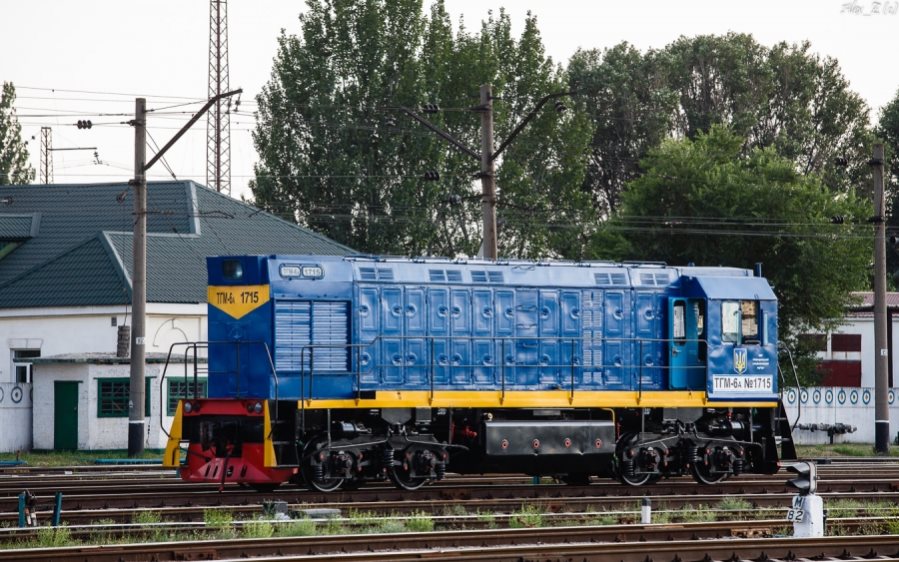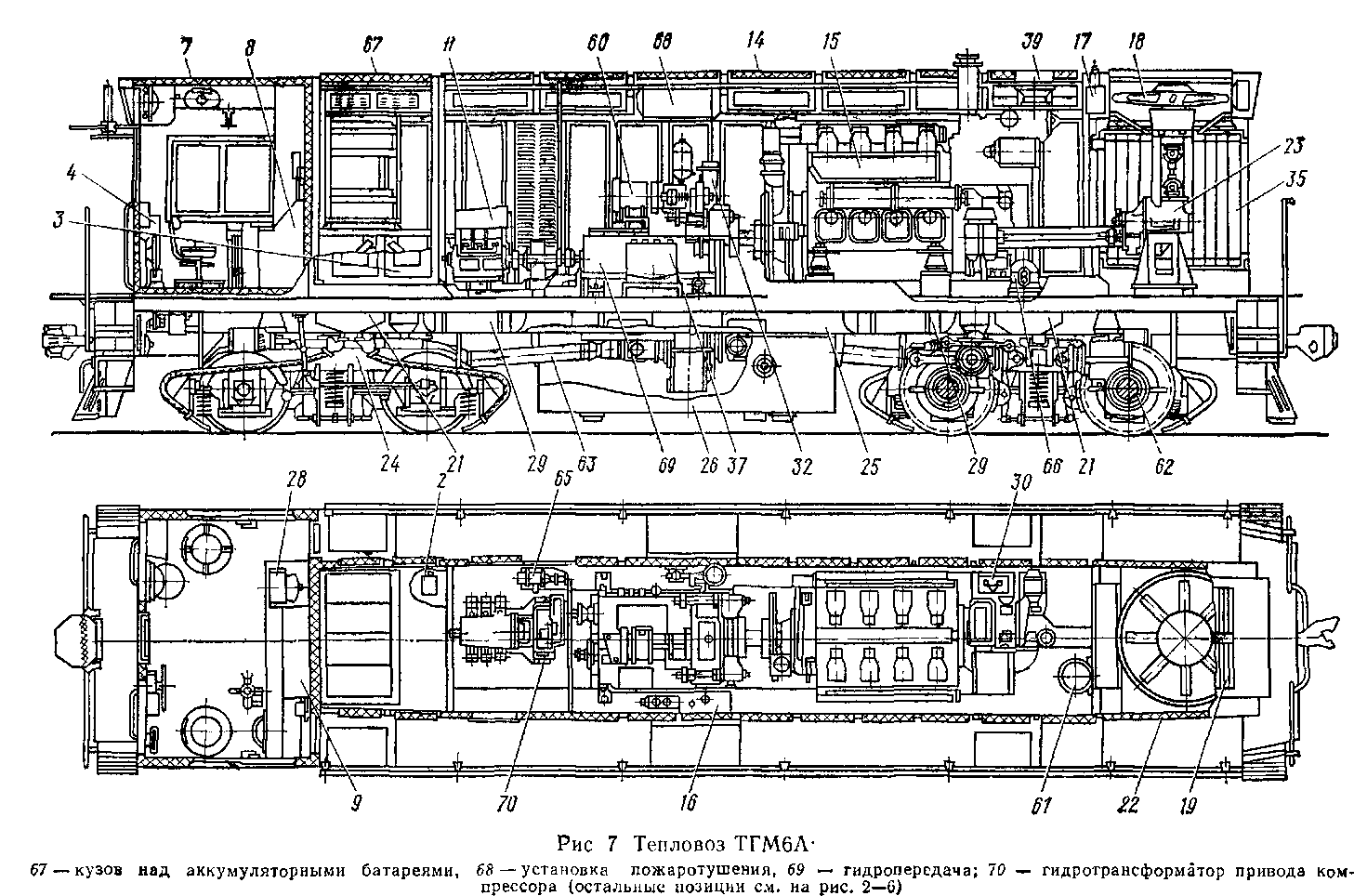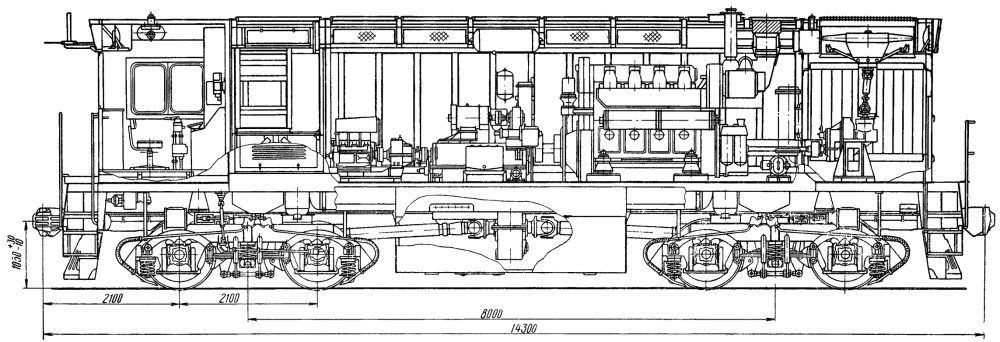TGM6 series diesel locomotives
 TGM6 is a four-axle diesel locomotive with hydraulic transmission, designed at the Lyudinovo Diesel Locomotive Plant. In general, it is similar to TGM3, 4, 5. In 1964, the project of this diesel locomotive was developed, and 1966 the first one was built. This diesel locomotive has been manufactured since 1967. The first batch of diesel locomotives (62 cars) was built in the period from 1966 to 1970.
TGM6 is a four-axle diesel locomotive with hydraulic transmission, designed at the Lyudinovo Diesel Locomotive Plant. In general, it is similar to TGM3, 4, 5. In 1964, the project of this diesel locomotive was developed, and 1966 the first one was built. This diesel locomotive has been manufactured since 1967. The first batch of diesel locomotives (62 cars) was built in the period from 1966 to 1970.
Design
TGM6 is a frame-mounted two-wheel diesel locomotive with cardan transmission from hydraulic transmission to wheelsets. Two-stage axial gearboxes – the first stage is tapered, the second stage is cylindrical. Diesel 3A-6D49 – V-shaped, 8-cylinder, from the standardized series CHN26 / 26 (four-stroke with supercharging, cylinder diameter and piston stroke – 260 mm) of Kolomna Plant, other modifications of which are installed on TEM7 diesel locomotives, 2TE25A, upgraded M62 (12 -cylinder), 2TE116, TEP70, TEP150 and upgraded 2TE10 (16-cylinder), river vessels and ships (20-cylinder).
On TGM6, as well as on other domestic locomotives with hydraulic transmission (TGM4, TG16), there is a unified hydraulic transmission in modification UGP-1200. The transfer includes two torque converters for starting and accelerating, a fluid coupling for driving at high speeds and a reverse-mode gearbox for selecting the mode (shunting or train) and the direction of movement. In the train mode, the diesel locomotive has a maximum thrust force of 14 ts at a speed of 14 km / h and a maximum speed of 80 km / h, on shunting it is 25.1 ts at a speed of 8.6 km / h and 40 km / h, respectively. Management UGP – electric. From reverse-mode gearbox to axle gearboxes of internal (2nd and 3rd) wheel sets, drive shafts go, from internal gearboxes – shafts to external (1st and 4th). Each axial gearbox has an oil pump with a valve box, which allows the pump to create pressure regardless of the direction of the locomotive. Poured into gearboxes transmission oil TSP.
Diesel control – electric remote with eight positions of power, minimum speed (0th and 1st positions) – 420 min − 1, maximum (8th position) – 1000 min − 1. The drive of the refrigerator and compressor fan – through adjustable hydraulic fluid clutches, which ensures 2/3 of the compressor capacity at the first position, full performance – from the 3rd position, with a further increase in diesel engine revolutions, the valves on the hydraulic clutch open and the compressor revolutions are maintained at 1450 min – one. Compressor – 6-cylinder V-type type PK-5.25. The start of a diesel engine is electric from the electric starter ES-2, the voltage of the onboard network is 75 V, given by the 32TN-450 battery, and when the diesel engine is running, an auxiliary generator KG-12 installed on the hydraulic transmission.
Modifications
TGM6A
Modified version. Changes were made during the production, in particular, the weight of the locomotive was increased. From 1970 to 1989, a total of 2,435 sections were built. A distinctive feature – the absence of a small hood.
TGM8
Main article: TGM8
Designed as a new series, but has much in common with the prototype (TGM6A). Export locomotive with a diesel engine 3AE-6D49 and hydraulic transmission UGP-1200. In addition to the basic version (TGM8), various modifications were produced – TGM8K, TGM8P, TGM8E, TGM8EK, TGM8KM.
TGM6B
As an experiment, TGM6A-0394 was equipped with jawless bogies and received a new TGM6B series.
TGM6V
A modernized diesel locomotive with improvements that later migrated to the TGM6D. It has a separate numbering and was released in the amount of 236 units from 1988 to 1990. This diesel locomotive uses 7-6D49 diesel with a working speed of 350–950 min-1 and hydraulic transmission with only two torque converters.
TGM6V-39XXX
In the early 1990s, the plant began production of TGM6V diesel locomotives for supply to Cuba. This option was identified similarly (TGM6B), but had a special numbering. The numbers were assigned in the five-digit format 39XXX, where 39 is the part of the number (range) corresponding to the locomotive series and XXX is the serial number (it should be noted that the TGM6D diesel locomotive created later also had an option for Cuba, and with the same range 39XXX; the numbering was continuous with TGM6V-39XXX). In this case, the designation TGM6V in Cuba also remained.
TGM6D
Available since 1991 (411 cars have already been produced). There are a lot of groundwork from TGM4B in the locomotive. One of the differences from the previous models – the presence of a small (rear) hood. From 250 numbers it is issued on jawless carts. Like its predecessor, the diesel locomotive is equipped with a 7-6D49 diesel engine (but other engines can also be used in the diesel locomotive).
TGM6D-39XXX
As it was said earlier, the TGM6D version was released for Cuba, with special numbers 39XXX. Similar to TGM6V-39XXX, the Cyrillic writing of the TGM6D designation on diesel locomotive hulls was preserved. After the collapse of the USSR in the early 1990s, at least eight diesel locomotives were built in the TGM6D version for export to Cuba. They had a weight of 78 tons (instead of 90 tons of the base model) and a diesel engine adapted for work in a subtropical climate. But some of these diesel locomotives were never sent to Cuba. They were converted to work in the climatic conditions of Russia and sold to industrial enterprises, but for some unknown reason they kept the Cuban numbers (on the sides, the series is designated as TGM6D-39XXX).


Copyright © New «Haivoron Diesel Locomotive Repair Plant» PJSC is with you from 2017. All rights reserved